The BlackBerry PlayBook Review
by Anand Lal Shimpi on April 13, 2011 9:00 PM EST- Posted in
- Tablets
- Smartphones
- RIM
- BlackBerry
- PlayBook
- Mobile
I suppose it's fitting that I should be the one to write our PlayBook review. Before Android and the iPhone, there were two mobile platforms/devices that I was hugely fond of: the Palm V and my BlackBerry. In fact, it wasn't until the iPhone that I finally let go of my last BlackBerry - moving on from the email era into the smartphone age.
Today's BlackBerry is of course very different than the devices I used in college. And the PlayBook is unlike anything RIM has ever done.
I don't believe any tablet maker has perfected the formula just yet. I made that abundantly clear in our review of the iPad 2. While you can't argue that Apple is the forerunner in the smartphone based tablet space, over the long term I still believe this is anyone's game. Remember, the leaders in the early days of the PC industry weren't the ones who ultimately dominated the mature market.
What follows is our review of RIM's first attempt at building a tablet. The PlayBook is far from perfect, but there's a foundation here that can be built upon if RIM has a good roadmap and good execution. And if you're a BlackBerry user, there's a lot of synergy to exploit.
| BlackBerry PlayBook Pricing Comparison | |||||
| 16GB | 32GB | 64GB | |||
| WiFi | $499 | $599 | $699 | ||
Let's get to it.
The Hardware
If we view the primary difference between the first and second generation of smartphone based tablets as being ergonomics and performance, the PlayBook falls squarely in between the two.
At 10mm thick the PlayBook (7-inch display) is more iPad 1 (9.7-inch) or Xoom (10.1-inch) than iPad 2 or Galaxy Tab 8.9, but what RIM lacks in thinness it makes up for in overall size. The PlayBook is an almost-pocketable tablet. Bigger than the 5-inch Streak and even bigger than the 7-inch Galaxy Tab, the PlayBook isn't a pain to port around. The PlayBook is small enough to snugly fit inside the outer pocket of a long men's winter coat or a lady's purse. While I definitely don't carry my iPad everywhere, if it were more functional I could see carrying the PlayBook with me more often than any other tablet.
The PlayBook's styling is modest, even for BlackBerry standards. The front has a single BlackBerry logo along the bottom bezel and a visible camera lens but that's it. Around back you've got RIM's logo, a larger lens for the rear-facing 5MP camera sensor and a sea of black.
The only buttons on the device are along the top of the PlayBook: power, volume down, pause/play and volume up. The power button is flush with the surface of the PlayBook's edge. You basically need a pointy finger nail (which I typically don't have) to press it easily and as a result the power button was pretty much useless to me. If you can manage to hit it the power button will lock the PlayBook, otherwise you'll have to leave the tablet idle until it automatically goes into standby. RIM tells me that final versions of the PlayBook will have this power button raised by 0.8mm, enough to make it easily clickable.
Press and hold the power button and you'll be greeted with a PC-like choice to either power off the PlayBook or restart it. I'm not sure how frequently RIM expects you to do the latter, but when testing it's a nice feature to have.
The volume up/down buttons work as expected, although the volume level itself doesn't seem to be very linear. There's a single 1/8" headphone jack up top, near a port for the PlayBook's microphone.
The PlayBook features a pair of pretty loud stereo speakers on the front of the device. Being used to the iPad's single speaker, the PlayBook's two speakers are nice.
Charging is always an issue on these USB devices. You can take Apple's approach and charge over USB, which unfortunately can take a while to fill up a tablet's battery. You also run into issues with older computers that don't support the USB Charging spec, resulting in charging-only-while-sleeping like the iPad. Then there's Motorola's approach with the Xoom where you don't charge over USB but have a dedicated port for an AC adapter. Charging times are significantly reduced but now you need to carry around an extra adapter with you wherever you go. RIM arrived at what's quite possibly the best solution. The PlayBook will charge over USB and it also features a higher amperage quick-charge port for use with some of its accessories.
The battery is of course not removable and there's no USB port or SD card reader.
The Form Factor
The PlayBook is only slightly larger than Samsung's 7-inch Galaxy Tab and maintains the same 7-inch screen size (albeit with a functional border around the screen). Given my complaints about current tablets not being incredibly portable compared to a smartphone, you'd think that I'd love the PlayBook's form factor. To be honest, for portability, I do.
| Tablet Specification Comparison | |||||
| Apple iPad 2 | BlackBerry PlayBook | Motorola Xoom | |||
| Dimensions | 241.2mm x 185.7mm x 8.8mm | 194mm x 130mm x 10mm | 249.1mm x 167.8mm x 12.9mm | ||
| Display | 9.7-inch 1024 x 768 | 7-inch 1024 x 600 | 10.1-inch 1280 x 800 | ||
| Weight | 601g (WiFi only) | 425g | 730g | ||
| Processor | 1GHz Apple A5 (2 x Cortex A9) | 1GHz TI OMAP 4430 (2 x Cortex A9) | 1GHz NVIDIA Tegra 2 (2 x Cortex A9) | ||
| Memory | 512MB | 1GB | 1GB | ||
| Storage | 16GB up to 64GB | 16GB up to 64GB | 32GB + microSD card | ||
| Pricing | $499 up to $829 | $499 up to $699 | $599 - $799 | ||
While I'm almost never tempted to bring the iPad with me when I'm going around town, the PlayBook is a far easier sell. It's almost pocketable (and actually pocketable if I'm wearing a big jacket) and isn't too heavy.
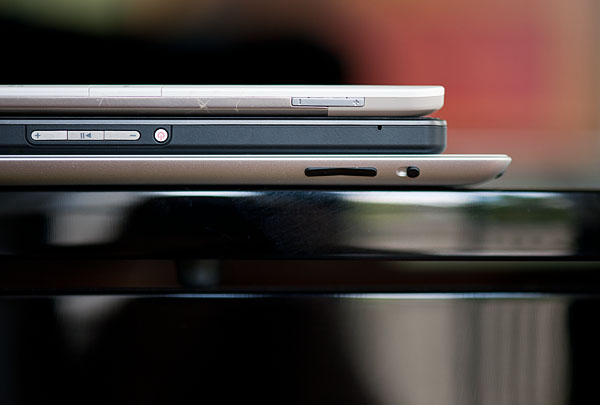
From top to bottom: Amazon Kindle 2, BlackBerry PlayBook, Apple iPad 2
Even when I'm not out and about, the PlayBook is quite usable as a content consumption device. In portrait mode fonts are a bit too small for me to read comfortably on the couch but in landscape it works well as a reddit browsing machine.
It's in the couch-lounging usage model that the PlayBook does fall short of the iPad or Xoom. But in terms of portability the PlayBook is clearly a much better balance of functionality and mobility. If you read between the lines you'll come to the same conclusion I have: neither the PlayBook nor the iPad is the perfect form factor for a tablet. Further more, I'm not sure there is a single perfect tablet form factor.
Apple tends to be a one-size-fits-all company when it comes to iOS. You want a smartphone? That'll be a 3.5-inch screen on an iPhone. Want a tablet? 9.7-inch iPad. It's interesting given how carefully Apple selected its four notebook sizes: 11, 13, 15 and 17-inches.

Clockwise: Apple iPad 2, Amazon Kindle 2, BlackBerry PlayBook in Convertible Case
Ultimately I don't think tablets will fall into the one-size-fits-all category. Instead I believe they're ultimately headed for some sort of a convergence with netbooks or notebooks. Today that's difficult to see because they lack a common hardware ISA, OS and even apps, but you don't have to look too far into the future to see those problems going away.
While I appreciate the PlayBook's portability and would definitely carry it around more than an iPad, it's not as nice to use laying back on a couch. The screen is too small to comfortably read in portrait mode and even in landscape things can get a bit cramped.
RIM's market research shows a clear preference for portability, hence the PlayBook's introductory 7-inch form factor. However RIM also pointed out that the BlackBerry comes in all shapes and sizes, indicating that the PlayBook would ultimately be available in different form factors as well. RIM also indicated that the 7-inch PlayBook may not be the smallest size offered either. Clearly RIM views the tablet market much like the notebook market: there will be ultraportables and there will be workhorses, with tons of choice in between. The 7-inch PlayBook is merely a starting point. Assuming RIM can fund the projects, we'll likely see both larger and smaller siblings in the future.


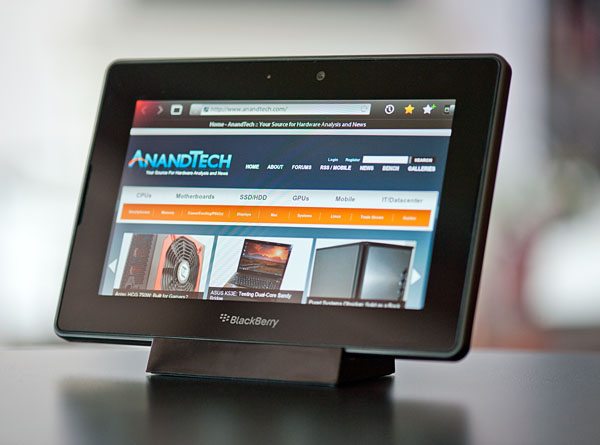
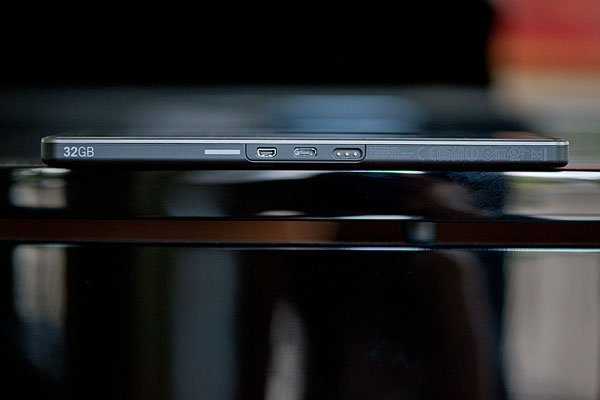
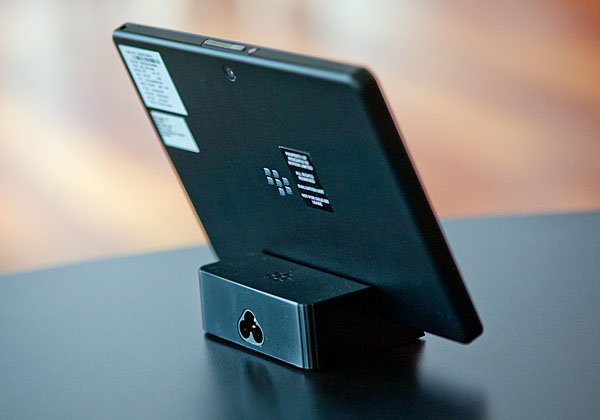
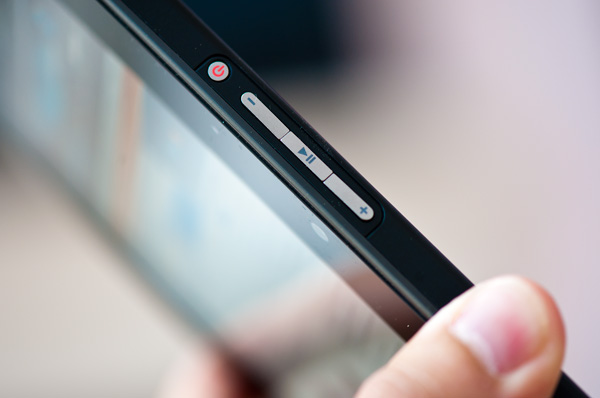
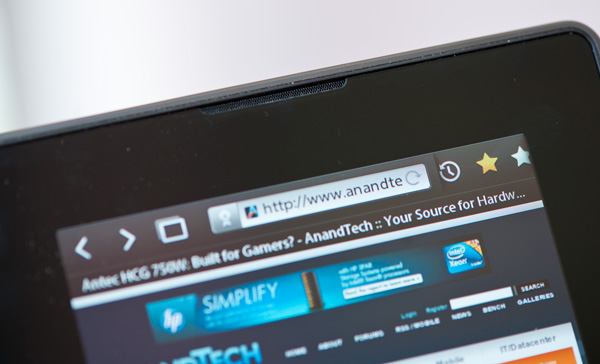








77 Comments
View All Comments
PeeluckyDuckee - Thursday, April 14, 2011 - link
The Android platform UI is very unpleasant to work with and an eye sore, looks like something from yesteryears. The hardware supporting it is slow and lag is quite apparent, whether that is a software or hardware issue doesn't matter as in the end the user experience leaves a bitter taste in my mouth.Apps is a non issue imo as time goes on it will slowly come. The major titles will be available cross platform. I buy it for what it offers me now, I don't rely solely on what will come later.
The QNX UI is very smooth and true multitasking is available. 7" form factor is perfect for my needs. Battery life is less of an issue as it will be rarely transported, but if I do need it for extended periods outside of the house it'll be either plugged into the car charger, into my USB battery pack, or plugged into the USB charger in the plane.
5" is too small and 12" is too big for me, so I will eventually have the best of both worlds and juggle between the 7" Playbook and the 10" iPad 2. Both are priced cheap enough that it doesn't have to be mutually exclusive, considering how much laptops/desktops/tablets used to cost it's a no brainer.
bplewis24 - Thursday, April 14, 2011 - link
If you expected anybody to read your post, you shouldn't have destroyed your credibility with your opening sentence.Stuka87 - Thursday, April 14, 2011 - link
It seems like many of the Tablets (and even phones in some cases) these days are being rushed out. I can understand the rush to get a product to market to try and grab market share early before competing products get to well entrenched, but coming out with a product that is short of features seems like it could be just as bad.Take WP7 for instance, in general it has some good concepts, but is missing a lot of features, as well as a usable browser. Updates will fix this, but the initial reviews have hurt it I think.
Then you have Android 3.0 which only works on Tablets, and has issues with them as it is. It was definitely rushed out to try and grab some market share before Apple gets much more entrenched.
Then we have this device, which has some cool features, but many features that will not be available until sometime this summer.
I realize the companies have to found a balance between getting a product out and finishing it, but it seems in some cases its cut too close. And we end up with a product that could have been great if only it had spent a bit more time in development.
On a side note, I do NOT like the screen on this device. Its way to narrow. I would not enjoy having a screen with that aspect ratio.
xype - Thursday, April 14, 2011 - link
"It seems like many of the Tablets (and even phones in some cases) these days are being rushed out."Just shows how much of a lead Apple actually has with the iPad. Most of the stuff out by now can't even compete with iPad 1, much less 2.
And even _when_ they get some small details right, it's the overall experience that makes the iPad's competition suffer.
Also, I quite like iPad's 4-finger-gestures for multitasking—too bad you have to set up your iPad as a development device to activate the preference in the first place…
medi01 - Thursday, April 14, 2011 - link
No "confusing" memory card slots, eh?melgross - Thursday, April 14, 2011 - link
The problem with memory slots are that what happens to your data and apps when you want to add another card? Usually you can't do that, you're stuck with what you've got, because part of the app resides on the card, and the rest in built in memory. So show lose the card, or it gets damaged, and you're in trouble.Manufacturers are using slots to make their devices look less expensive,
Urging the responsibility on the buyer to spend the extra cash to expand their memory. The problem is that most people, even those who are technically adept (or who pretend to be), don't realize that cheap Flash memory cards are a lot slower than the Flash inside their device. In order to keep the speed, they've got to buy more expensive memory cards. They haven't really saved much, if anything, if they do that. I'd rather pay upfront, and know that what I'm using is what I'm supposed to be using.
silverblue - Thursday, April 14, 2011 - link
The date format of the video of the dog is in YYYY-MM-DD format... sorry, I just enjoy seeing non-American date formats for once. :)It's a promising tablet design, but they've got a way to go before it can be a true competitor to the iPad 2. The lack of an e-mail client doesn't sit well with me, but the inclusion of 1080p High Profile H.264 support is excellent, and it's light.
Conficio - Thursday, April 14, 2011 - link
I'm usually not that interested in video in such devices, but your sample videos could really use some image stabilization.On such a large device that should be mandatory.
Griswold - Thursday, April 14, 2011 - link
An otherwise very interesting product suffers from two shortfalls:1) Too small. As mentioned in the article, its a matter of what you do, where you do it and personal preference. Personally I prefer the 9-10" size.
2) Its far from finished. Every other thing needs tning, tweaking, polishing or is completely missing. Why bother handing out review units, RIM? You're just damaging your products reputation!
GnillGnoll - Thursday, April 14, 2011 - link
"I've complained in the past about the input problem on tablets, and I do believe it's actually worse on the PlayBook thanks to its cramped screen resolution."While higher resolution might help a little by allowing text to be slightly smaller while keeping it legible, this is really about area not resolution. You can't make the on-screen keyboard or address bar much smaller physically without significantly affecting their touch usability.